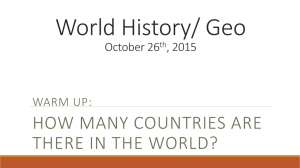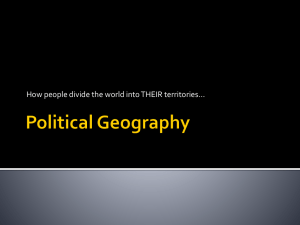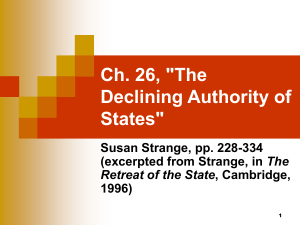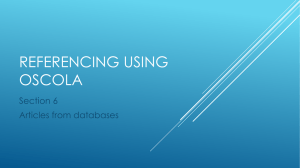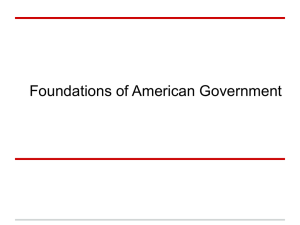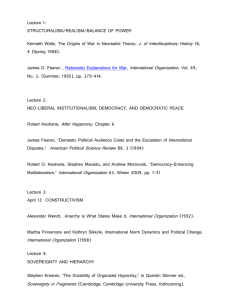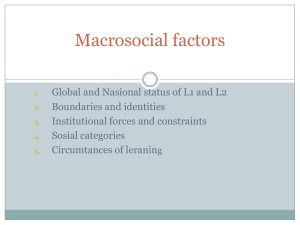AP Human Political Geography Study Guide What is a political unit
advertisement
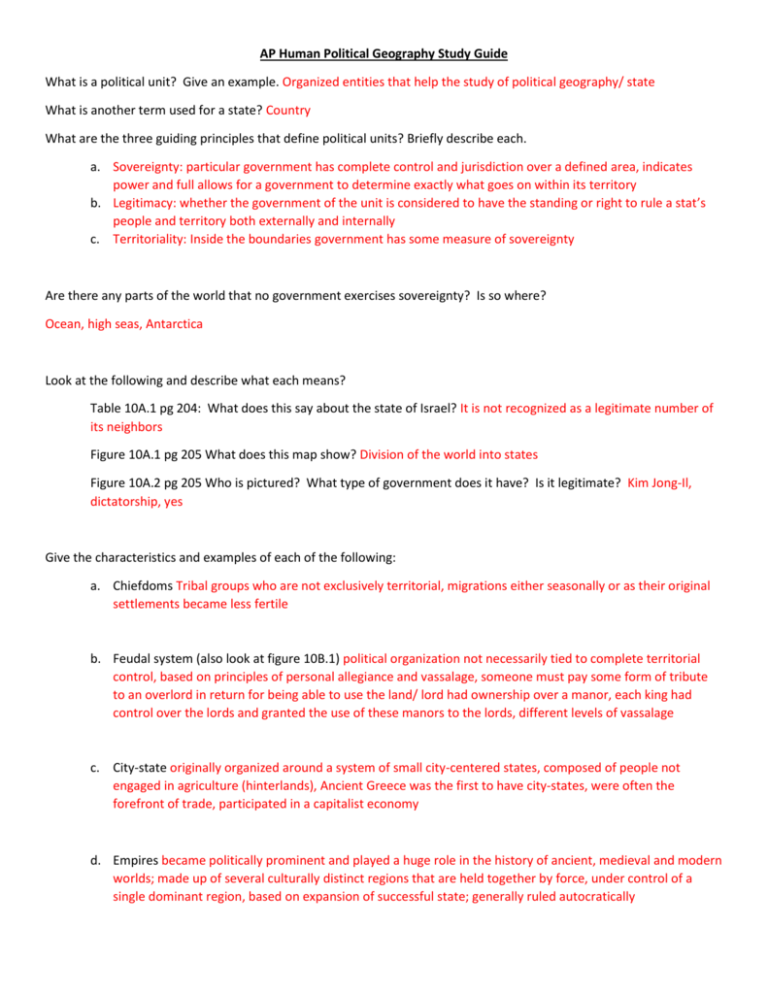
AP Human Political Geography Study Guide What is a political unit? Give an example. Organized entities that help the study of political geography/ state What is another term used for a state? Country What are the three guiding principles that define political units? Briefly describe each. a. Sovereignty: particular government has complete control and jurisdiction over a defined area, indicates power and full allows for a government to determine exactly what goes on within its territory b. Legitimacy: whether the government of the unit is considered to have the standing or right to rule a stat’s people and territory both externally and internally c. Territoriality: Inside the boundaries government has some measure of sovereignty Are there any parts of the world that no government exercises sovereignty? Is so where? Ocean, high seas, Antarctica Look at the following and describe what each means? Table 10A.1 pg 204: What does this say about the state of Israel? It is not recognized as a legitimate number of its neighbors Figure 10A.1 pg 205 What does this map show? Division of the world into states Figure 10A.2 pg 205 Who is pictured? What type of government does it have? Is it legitimate? Kim Jong-Il, dictatorship, yes Give the characteristics and examples of each of the following: a. Chiefdoms Tribal groups who are not exclusively territorial, migrations either seasonally or as their original settlements became less fertile b. Feudal system (also look at figure 10B.1) political organization not necessarily tied to complete territorial control, based on principles of personal allegiance and vassalage, someone must pay some form of tribute to an overlord in return for being able to use the land/ lord had ownership over a manor, each king had control over the lords and granted the use of these manors to the lords, different levels of vassalage c. City-state originally organized around a system of small city-centered states, composed of people not engaged in agriculture (hinterlands), Ancient Greece was the first to have city-states, were often the forefront of trade, participated in a capitalist economy d. Empires became politically prominent and played a huge role in the history of ancient, medieval and modern worlds; made up of several culturally distinct regions that are held together by force, under control of a single dominant region, based on expansion of successful state; generally ruled autocratically What is the difference between a metropole and a colony? Metropole is the dominant part of the empire and the parts of the empire that are subordinated and have very little right to self-determination is a colony What where the four major changes that occurred to create the modern state system, briefly explain each 1. Growth of the Westphalian state system, based on the idea of a world composed of autonomous, clearly bounded, sovereign territorial states 2. Growth of nationalism and the nation-state ideal; changed attitudes toward what constitutes the state, role of residents and the role of a government assumed to have national legitimacy 3. Europe’s impact on much of the non-European world, influence on the shape of many modern countries, balance of political, economic and cultural power; diffusion of the Westphalian state system; Spain, Portugal, France, England and the Netherlands developed overseas empires 4. Decolonization within the last two centuries; US was first to declare it independence, followed by other New World colonies Give an example of a satellite state. (States with less actual sovereignty) Soviet Union over Eastern European countries which did not have the freedom to exercise their own foreign policy or make internal changes What are micro-states? Give examples. Which is the smallest? Tiny states, very small but are still considered to possess a certain degree of sovereignty, legitimacy and territory/ Vatican City How does the term nation differ from the term state? Nation represents the group of people who feel that they belong together; state refers to the land they occupy What are the four markers of a state? Briefly describe each 1. Shared cultural heritage or belief that helps unite a group of people and distinguishes them from their neighbors; can be a shared language or religion, can be based on historical legacy 2. Loyalty: people’s allegiance, so powerful that people are willing to give their lives to ensure the continued existence of the group; to all the people of that nation (horizontal); prior to nation-states loyalty was placed to the ruler (vertical); nation expects a primary loyalty which transcends that of other allegiances; exclusivity that a person is loyal to only one nation 3. Territorial Expression: what a nation considers to be its natural homeland; they may not be found in a territory demarcated and contained in a place, they may be spread out but still have a strong sense of a distinct space and of places enshrined in national memory 4. Political goals: seek self-determination (allowed to form their own sovereign state) Look at figure 10E.1 pg 212 what is the difference between ethnic and civic nations? Ethnic nations are based on cultural commonalities (Japanese) and civic nations are based on shared principles (The United States) Describe the following nation-state relationships and give examples of each: 1. Nation-state ideal that every nation should have control over a state: Germans should live within the country of Germany, governed by German leaders and partake of German institutions; there is no true nation-state but some come close: Japan 2. Multinational state A country contains more than one nation, most countries fall into this category; often there is a dominant nation who is in control of the state, other nations may be recognized by the state or may be ignored and repressed; ex US 3. Multistate nation: Nation encompasses more than one state, may or may not control of the state, may seek ways of joining the pieces together, ex: Iraq invaded Kuwait claiming it was part of the Iraqi nation 4. Stateless nation: Nation has no state to call its own, they may straddle several states or be contained within the boundaries of a single state; ex: Palestinians & Kurdish 5. Diaspora People who consider themselves to be part of a nation are not consolidated spatially, most often there is a homeland or territory that the group identifies with but the group is dispersed; fell a sense of national commonality but without any form of spatial connections; ex: Jewish people Look at figure 10F.2, what is the map showing? Be specific. The two dominant nations of Canada: English-speaking and French-speaking; French are mainly concentrated in the province of Quebec, they have pushed for greater political sovereignty; Canada has begun to acknowledge the presence of other distinct nations made up of indigenous people (First Nations) Look at figure 10F.4, who lives in the highlighted region? How do we classify them as a nation? Kurds who live in Turkey, Iraq and Iran: stateless nation What is the difference between centripetal and centrifugal forces? Give examples of each. Centripetal unify and bring together (nationalism, less likely to be rebellious and more likely to make greater personal sacrifices for the good of the nation); centrifugal: pull apart and disperse; can be caused by ehtnoregionalism where a minority national group is concentrated in a particular region of the country often too small to pose a threat to the state but may create a variety of difficulties, may lead to separatist movements, may receive some autonomy What is the term used to describe people who want to separate from their existing state in order to join a neighboring state? Irredentist movements Which type of boundary separates one state from another? International boundary What does de jure area and de facto areas signify? De jure: legal area of the state controls the territory; de facto: territory a state controls but is not included in the legal area What term is used to describe the edge of a settlement? Frontier Are there true natural boundaries? Why or why not? No; because countries have passed over them to include as much are as they could, given military strength or capacity to govern; landforms can change Give examples of natural and geometric boundaries: Natural: oceans, mountains, rivers; Geometric: man-made imaginary lines of latitude/longitude that do not take into consideration cultural or natural features Which type of boundaries were created before an area is known or populated? Which boundaries are created after recognized settlements? Antecedent boundaries/ subsequent boundaries All international boundaries share the same basic purpose, separating one state from another, but they disrupt traffic (people, goods or information). Secondly boundaries represent division between two realms of governments, two economic systems and two different levels of welfare. Thirdly boundaries help embody the edge of national identify. Look at figure 10H.12 pg 221, what is the map showing? 12 Euroregions that are designed to enhance the significance of border areas, help promote interactions between people, develop particular institutions and develop councils When was containment introduced? By whom? Why? After World War II; United States; Policy to limit any Soviet advance to any nonaligned countries thereby containing Communist expansion; Look at figure 10I.3 pg 223: What is this map showing? Division of geopolitical realms that evolved after the Cold War by Saul Cohen; regions are formed by spatial contiguity and political, military, cultural and economic interactions; Shatterbelts are regions that are politically fragmented and are often areas of competition between to ideological or two religious realms (SE Asia) What is critical geopolitics? The way state boundaries are perceived, relationships between states and the ways the world is portrayed What is the difference between public and private sectors? Public: capitalist society-state run functions (external relations, providing serves, tax collections, defense & judicial system); Private: in a capitalist society: all the factories, firms and offices responsible for producing goods and service not run by the state (privately owned businesses) Study the figures on pages 230-231, describe which type of economy is represented in each graphic. Figure 11B.1 Extraction Economy: traditional kingdoms that sought to enrich the ruler and the aristocracy and to maintain its armies Figure 11B.2 Capitalist economy: state takes on a different role required taxation to ensure that it could perform those services (foreign relations, defense and judicial system) later acquired other functions as well Figure 11B.3 Communist economy: Sate assumed nearly all economic and social functions and tried to impose comprehensive control over economic activities Figure 11B.4 Mixed economies: Government controls certain economic activities it considers key or appropriate to the public trust while leaving others in the hands of the private sector Give examples of each of the following: Elite theories of the state See government as supporting an elite class of people, favored by the government, state is not a neutral entity but promotes the interests of a particular group (US, Australia & UK) Marxist theories of the state look at the state as a vehicle promoting capitalism and the capitalist class, have key figures who represent the capitalist class or its interests (Soviet Union; China) Authoritarian states Concentrate political power in a single individual or clique (oligarchy), no opposition is allowed (North Korea) Look at the following figures (pg 233), what is each saying about the government’s systems in each country: Figure 11C.3 China, government controlled everything, under Mao Zedong everyone was expected to uphold the party line and values Figure 11C.4 Robert Mugabe in Zimbabwe intimidated voters to ensure his success but the voters did could not exercise their rights What is the difference between a subject and a citizen? Subjects were residents of a state during monarchical, feudal or imperial settings who were given few rights; citizens embodies the responsibilities and rights that residents of a state possess, are able to decide who should be in the government through voting and are entitled to a certain level of justice, free speech and association Describe the thoughts of jus sanguinis and jus soli, give examples Jus sanguinis applies to the idea that citizenship is based on that of your parents (if your parents are from a country but you are born in a different country, you have citizenship of your parents country); jus soli: applies whenever citizenship is acquired through birth within a state’s territory (US, children of immigrants are granted automatic citizenship rights by virtue of birth on US soil) What are unitary states? Give an example. Nearly all sovereignty and power reside with the central government, can determine how each subdivision is governed and can appoint an administer, designate district boundaries; France Look at the following figures Figure 11E.5 (pg 238) Which state was the first organized federation? United States Figure 11E.6 (pg 238) Who set up the system of government and what did it do? British; set up two systems of sovereignty one for the central government and one for each province, created a federal system Figure 11E.7 (pg 239) How many republics made up the Soviet Union? Did the individual republics have power? What is devolution? 15; yes, some degree of sovereignty; granting of power to lower administrative units by the central government What is the difference between federal states and confederations? Federal states: each subunit is granted an independent constitutional authority which defines its level of power, central state still has greater sovereignty and is expected to conduct foreign affairs Confederations: sovereign states agree to abridge some of their independent powers in order to work together as a group but each state retains a great deal of sovereignty Describe the location and significance about capitals found in different states (pgs 244-245): Figure 11F.5 Rome chosen based from the historic center of the country, core area from which the state and nation evolved Figure 11F.6 Jakarta Former colonial capitals, may have not been important before European conquests, they served as the center of the colony and after independence became the center for the new country Figure 11F.7 Ottawa Creation of a new city to serve as the capital or designate an existing smaller city (introduced capitals) reflect a break from regional interests and an orientation toward the future; compromise capital between different sectional interests within the country; Ottawa was chosen to serve at the boundary between the French-Speaking and English-speaking portions Figure 11F.8 Brasilia Forward capital, intended to help move population toward less populous areas Figure 11F.9 Islamabad Alternatives to old colonial capitals Figure 11F.10 Ankara Established near the most central area of the country What are special regions? Give examples (use the figures to describe the different types of special regions)? Political subunits that are granted different powers than regular subunits (capital regions), treated differently because it has to work harder to maintain effective control or has to accommodate a region that is culturally distinct in some way; Tobago is separated from Trinidad; exclaves and enclaves; Canada’s provinces vs its territories; US and Puerto Rico What is a reservation? Give an example. A territory for indigenous peoples; American Indians What is the purpose of gerrymandering? To concentrate the support of one party or one group of people in one district and dilute their support throughout a number of other districts
